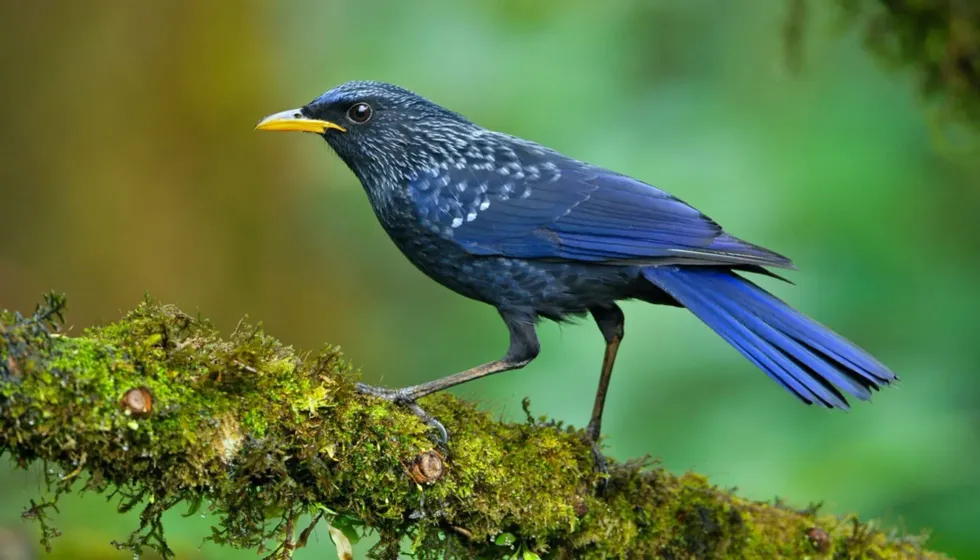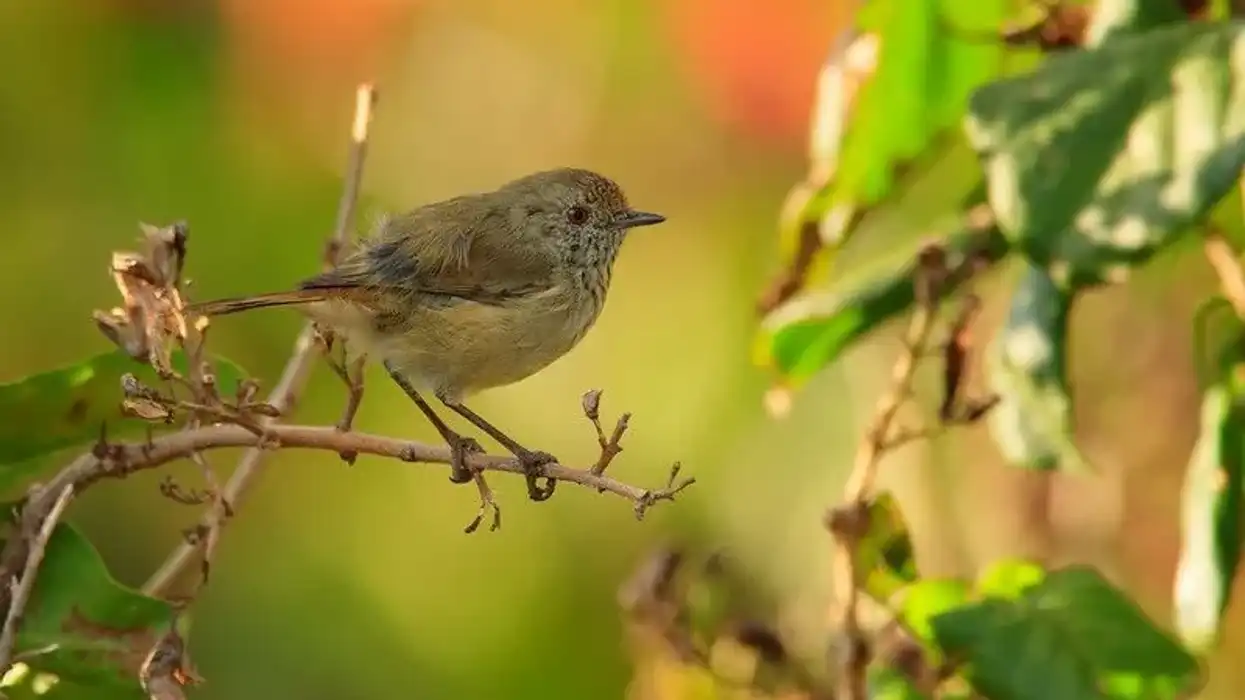The blue whistling thrush bird is a species of whistling thrush endemic to the Himalayan and Tian Shan mountains of Asia, particularly Central Asia, Central and Eastern China, India, northern Burma, other countries of South Asia, as well as Southeast Asia.
The blue whistling thrush bird is renowned for its songs at dawn and dusk which are human-like whistles. This bird is a carnivore that eats a variety of foods like water beetles, insects, and grasshoppers.
It is a beautiful, violet-blue species of birds that adorn the forests that it inhabits.
The blue whistling thrushes live alone but get together for the breeding season, for mating and laying three to four eggs at a time. It defends its nest which is in caves or on cliffs, from larger birds like hawks, cuckoos, as well as raptors.
Although the exact population or the population trend remains unknown, the blue whistling thrush bird is considered to be a species of Least Concern by the International Union for Conservation of Nature.
Keep reading to learn about these colorful, loud birds. For more relatable content, check out these hummingbird facts for kids and blue jay surprising facts pages.
Blue Whistling Thrush Interesting Facts
What type of animal is a blue whistling thrush?
The blue whistling thrush (Myophonus caeruleus) is a bird.
What class of animal does a blue whistling thrush belong to?
The blue whistling thrush (Myophonus caeruleus) bird belongs to the Aves class animals.
How many blue whistling thrushes are there in the world?
The total number of blue whistling thrush bird populations in the world is unknown.
Where does a blue whistling thrush live?
The blue whistling thrush (Myophonus caeruleus) bird is found in the mountainous range, subtropical, and tropical forests in the Tian Shan and Himalayan range in Central, Southern, and Southeastern Asia. The blue whistling thrush range map includes the countries of India, China, Indonesia, among others.
What is a blue whistling thrush's habitat?
In its preferred habitats among the mountains, the blue whistling thrush (Myophonus caeruleus) bird populations frequent ravines, rocky streams, rivers, and gorges. It frequents large trees in open bushes and deciduous forests, as well as scrubs, mangroves, lowlands, gardens, and even farm fields.
Blue whistling thrushes live in elevations of 3300-13,000 ft (1,000-4,000 m) during the breeding season, and up to heights of 7900 ft (2,400 m) in the winter. The species shows altitudinal movements in the mountains of the Himalayas, alongside India.
Who do blue whistling thrushes live with?
Blue whistling thrushes (Myophonus caeruleus) live alone or with their mates.
How long does a blue whistling thrush live?
Blue whistling thrushes (Myophonus caeruleus) may live for 5-10 years.
How do they reproduce?
Blue whistling thrushes (Myophonus caeruleus) reproduce by mating laying eggs. The nesting and incubating duties are shared by the parents.
What is their conservation status?
The conservation status of blue whistling thrushes (Myophonus caeruleus) according to the International Union for Conservation of Nature is Least Concern.
Blue Whistling Thrush Fun Facts
What do blue whistling thrushes look like?
The blue whistling thrush (Myophonus caeruleus) is characterized by a violet-blue plumage. It may change in appearance color-wise when viewed under different lights.
The upper parts have blue spots, especially on the head and the crown. The underparts, belly, and breast are duller than the rest of the body.
The lores of the blue whistling thrush are black. The wing coverts on the upper side have small silver spots, there are white spots on the median coverts, and the lesser coverts make up a shoulder patch that is blue.
The tail and wings are a dark blue. The feet and legs are black. The eyes of the blue whistling thrush are a reddish-brown.
The sexes show little dimorphism, with the blue whistling thrush female being duller and slightly smaller than the male. Juvenile blue whistling thrushes have a sooty-black appearance with white streaks on their breasts.
Except for the description for one species (M.c. caeruleus) which has a black bill, the rest of the subspecies of the blue whistling thrush have a bright yellow bill with culmens that are black.

How cute are they?
The blue whistling thrush (Myophonus caeruleus) is truly one of the jewels of the forest. It is a glossy and beautiful violet-blue ornament that adorns the green forests and vegetation.
And because it inhabits places along the river, watching it in the wild is like watching a colorful painting or tapestry. It appears brighter or duller under different intensities of sunlight but that doesn't diminish its beauty.
There are deeper blue and silver spots all throughout its body, and as if as a cherry on top, they have bright yellow beaks. Their dawn and dusk songs are very melodic too.
How do they communicate?
Blue whistling thrushes (Myophonus caeruleus) communicate mainly via song and call that are loud, high-pitched, melodic, and human-like, usually at dawn and dusk. They also give out an alarm call which is short and shrill.
The alarm call, accompanied by a drooping tail, sounds like 'kreee' or a lengthier 'scree-chit-chit-chit'. The blue whistling thrush may also make a sharp 'tzeet-tze-tze-tzeet' call at dawn and dusk.
How big is a blue whistling thrush?
The blue whistling thrush is 11-14 in (29-35 cm) long, which makes it two times bigger than the hermit thrush.
How fast can a blue whistling thrush fly?
Blue whistling thrushes are fast and powerful fliers. They may achieve flight speeds of 25-50 mph (40-80 kph).
How much does a blue whistling thrush weigh?
A blue whistling thrush weighs 4.8-8.1 oz (135-230 g).
What are the male and female names of the species?
The blue whistling thrush male and female birds do not have specific names, but since they are birds, they may be referred to as cocks and hens respectively.
What would you call a baby blue whistling thrush?
A baby blue whistling thrush may be called a chick or a juvenile.
What do they eat?
Blue whistling thrushes feed on invertebrates, water beetles, ants, larvae, grasshoppers, slugs, snails, earthworms, small crustaceans, crabs, fruits, and insects.
Are they poisonous?
No, blue whistling thrushes are not poisonous.
Would they make a good pet?
No, blue whistling thrushes would not make good pets. They are wild birds that are very territorial. They are the jewels of the beautiful mountainous regions they inhabit and thrive in, and they should be left to adorn nature.
Did you know...
The M. c. temminckii subspecies is included with the small billed temminckii species of Afghanistan. The status of this species is also valid in India.
The kingdom, phylum, genus, species, order, and family of the blue whistling thrush are Animalia, Chordata, Myophonus, M. caeruleus, Passeriformes, and Muscicapidae respectively. The Passeriformes order, family Muscicapidae consists of the old world flycatcher birds. The phylum Chordata signifies any animals supported by a central skeletal bone.
The blue whistling thrush bird population belongs to the genus, species Myophonus, which consists of colorful old world flycatcher birds found in India.
What's special about blue whistling thrushes?
Blue whistling thrushes are almost completely a shiny, violet-blue color. This makes them look like a precious natural jewel amongst the green forests they live in.
The yellow-billed blue whistling thrush call is almost identical to the sound of a human whistle. They stay monogamous for the breeding season or even for a year. The breeding sites and nests that they build may be used again by themselves or a different pair.
They display fiercely aggressive behavior towards much larger birds that may intrude upon their territories such as large hawk-cuckoos, raptors, or owls. It displays aggression with puffed-out breasts.
How did blue whistling thrushes get their name?
The 'blue' in their name comes from the characteristic color of their bodies, which are almost entirely blue. The 'whistling' comes from the ability to make a call and song that closely resembles the whistling sounds made by humans.
Here at Kidadl, we have carefully created lots of interesting family-friendly animal facts for everyone to discover! Learn more about some other birds from our palm warbler facts and blue-winged teal facts pages.
You can occupy yourself at home by coloring in our free printable blue whistling thrush coloring pages.









